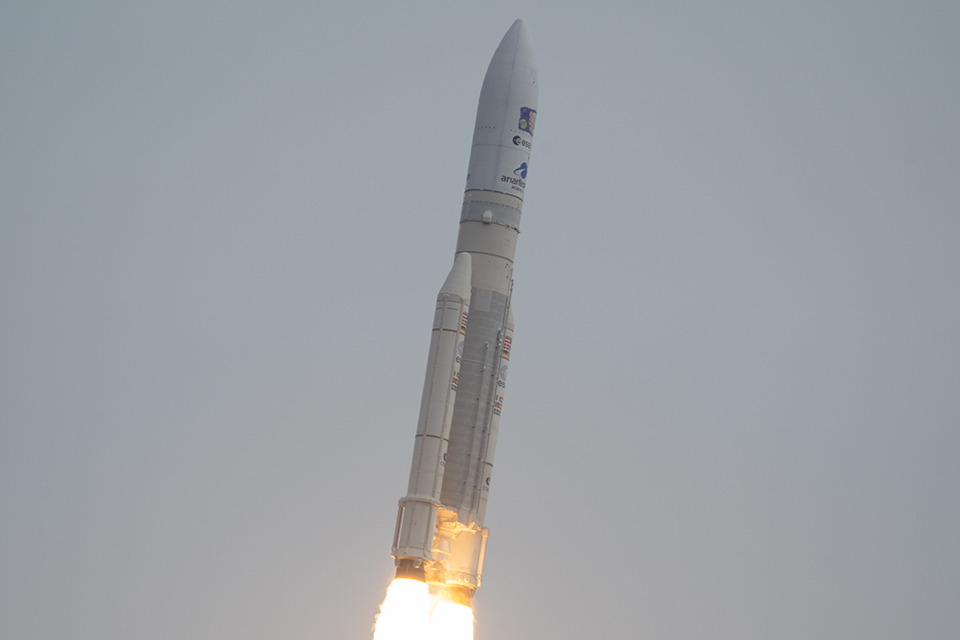The Jupiter icy moons mission (JUICE) has taken off on its journey to study Jupiter, our solar system’s largest planet, and investigate whether some of its icy moons are home to conditions that could support life.
Funded by the UK Space Agency, the UK leads on one of the 10 science instruments on board the European Space Agency’s Jupiter Icy Moons Explorer (JUICE) and has contributed to the development of two more.
Blasting off from Kourou in French Guiana at 1:14pm BST on Friday 14 April, JUICE will spend eight years travelling to the Jupiter system. On the way, it will perform fly-bys of Earth and Venus, using the gravitational fields of the planets to generate enough speed to reach Jupiter. One of these will be the first ever lunar-Earth gravity assist manoeuvre.
said:
“The UK Space Agency has invested around £9 million in the JUICE mission to explore Jupiter and its moons. UK tech on the spacecraft illustrates how our world class universities and research institutions are unlocking deep space exploration.
I want the UK’s space sector to continue thriving and encourage STEM learning for the next generation. It’s important that we push the boundaries of science, innovation and technology across the country to support the jobs of the future.” – Secretary of State for Science, Innovation and Technology.
On arrival in 2031, JUICE will circle Jupiter and fly past moons Ganymede, Europa and Callisto, making observations and taking measurements, studying the Jovian system as an archetype for gas giants elsewhere in the universe.
Finally in December 2034, JUICE will transfer into orbit around Ganymede, becoming the first spacecraft ever to orbit a moon other than Earth’s. While up close and personal with Ganymede, the mission will investigate the giant ocean that scientists believe hides under its icy crust, seeking evidence of habitability.
“The launch of JUICE marks years of hard work and collaboration by scientists, engineers and space agencies all over the world, but the journey is far from over.
We look forward to following the spacecraft as it makes its eight-year trip to Jupiter and then as it studies the planet and its moons, using specialised UK-developed science instruments.
We have a large community of research experts in the UK who are eagerly awaiting the data that JUICE will provide. With this information we hope to discover more about the nature of gas giants in space, and their icy moons, bringing us another step closer to understanding the evolution of the Universe.” – Dr Caroline Harper, Head of Space Science at the UK Space Agency.

The UK Space Agency invested £9 million into the JUICE science payload, by supporting three critical instruments on board, which are:
- J-MAG (UK-led magnetometer) – Development led by Imperial College London with radiation-hardness and mechanical design contributed by the University of Leicester.
- JANUS (Italian-led optical camera system) – Imaging sensors developed by Teledyne-e2v in the UK, then tested, calibrated and characterised by Open University.
- PEP (Swedish-led particle environment package) – Solid-state detectors provided by University College London and radiation design for instrument suite contributed by Aberystwyth University.
Principal Investigator for the J-MAG instrument at Imperial College London, Professor Michele Dougherty, has been involved in JUICE since well before it was selected by ESA in 2014 as the first Large Class mission in its Cosmic Vision Science Programme.
With our instrument’s measurements, we are almost looking inside these worlds. What we’re doing, however, is extremely difficult, as the signals we’re trying to detect are extremely small. It’s like trying to find lots of needles in a haystack, and those needles are changing shape and colour all the time. But we think the results are going to be spectacular.
Space missions are long and slow, so launch only marks the halfway point of this one – because we first started thinking about it 15 years ago, and we’ll be getting the last data in 15 years’ time. But I can’t wait for launch to happen because that’s the next milestone for us – we’ll be on our way to Jupiter.” – Professor Michele Dougherty, Head of the Department of Physics at Imperial College London.
JUICE is a collaboration between ESA, NASA and the space agencies of Japan and Israel and will consider two key themes from ESA’s Cosmic Vision 2015 – 2025: What are the conditions for planet formation and the emergence of life? And how does the Solar System work?
After taking off on an Ariane 5 launch vehicle from Kourou in French Guiana it is expected to arrive at Jupiter in July 2031 and complete 35 icy moon flybys before arriving at Ganymede – the largest of Jupiter’s moons – by December 2034.
JUICE will spend its eight-year voyage productively; it will pass by Venus to test and calibrate its instruments, gather data and take advantage of the gravity assist to save on fuel. Meanwhile, scientists on the ground will work on finalising software and data modelling in time for arrival at Jupiter.
The JUICE mission aims to answer many exciting questions, including whether the ocean worlds beneath the surfaces of Jupiter’s icy moons could potentially harbour life. One of the many instruments needed to make detailed scientific observations to help answer such questions is a camera.
Our team at the Open University has spent several years testing and optimising a new image sensor for JUICE’s scientific camera, JANUS. A large part of our work was to irradiate test sensors with high doses of radiation, just like it is expected to experience during the JUICE mission lifetime, to check that JANUS will still be able to take images without too much degradation.
We are now very much looking forward to watching the launch, albeit we’ll have to wait patiently for several more years before we’ll see the first images sent back from Jupiter’s moons. After many years of hard work from science, engineering, and industry teams, we are so excited that the JUICE mission is finally ready to launch and start its long journey to the Jupiter system. We will patiently await the incredible data that we expect to receive from 2031, and we are confident that it will absolutely be worth the wait!” – Chiaki Crews, Research Fellow at the Open University.




